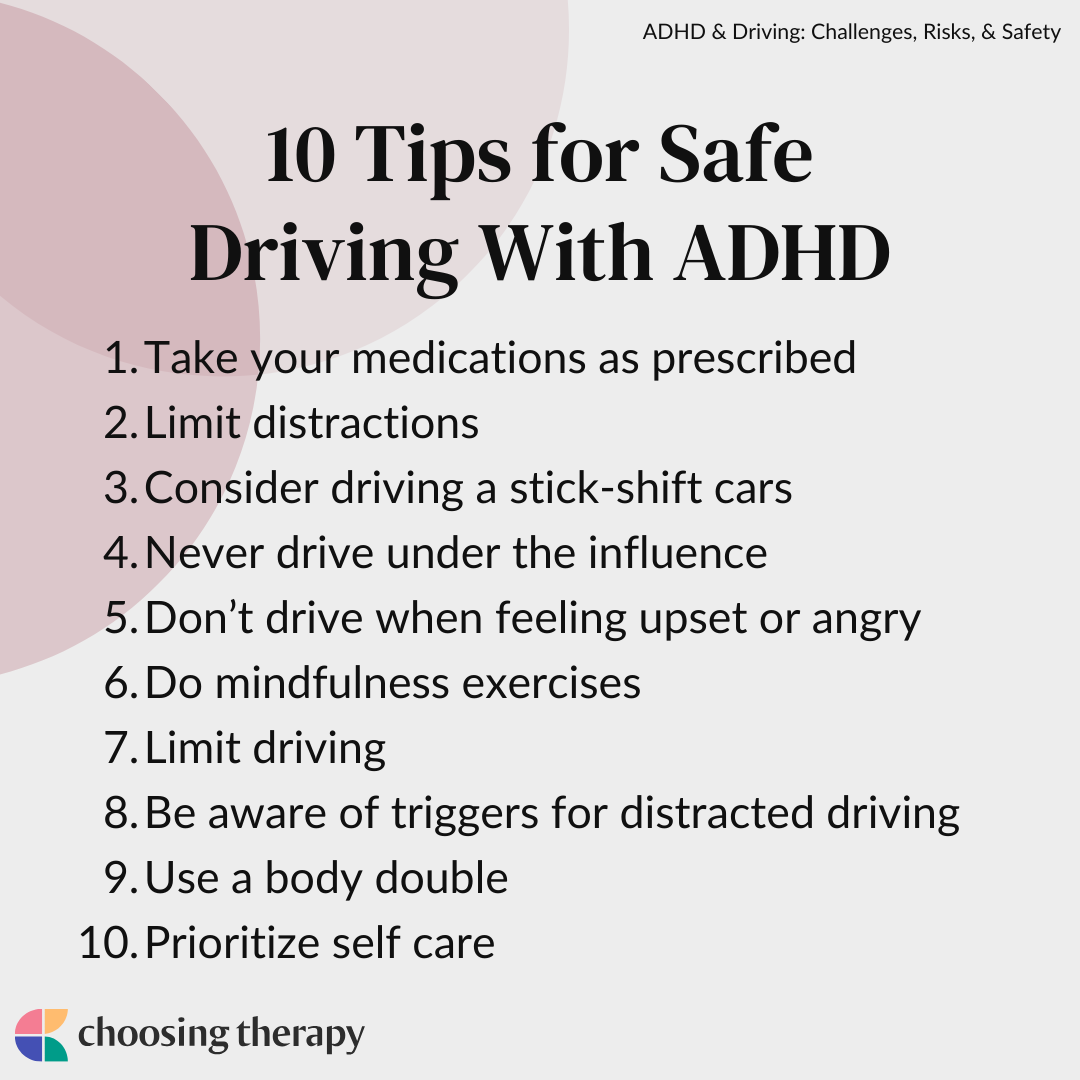Addressing Driving Safety Concerns For People With ADHD

Table of Contents
Understanding the Challenges: ADHD and Driving
ADHD, characterized by inattention, impulsivity, and hyperactivity, presents unique challenges for drivers. These symptoms can significantly impact driving abilities, increasing the likelihood of accidents. Let's examine how each symptom contributes to driving difficulties:
Inattention's Impact
Inattention, a core symptom of ADHD, directly impacts safe driving. Difficulty maintaining focus on the road leads to:
- Difficulty maintaining focus on the road: Mind wandering can lead to missed exits, traffic signals, or even entire stretches of road.
- Missing traffic signals or signs: Failure to notice stop signs, speed limits, or lane markings can result in dangerous situations.
- Slower reaction times: Delayed responses to unexpected events, such as sudden braking or lane changes by other vehicles, increase the risk of collisions.
- Increased risk of rear-end collisions: Inattention often leads to following too closely, resulting in rear-end collisions.
Specific examples include: zoning out while driving, being unaware of a car merging into your lane, or failing to notice a change in traffic flow.
Impulsivity and Driving
Impulsivity contributes significantly to risky driving behaviors:
- Tendency to make quick, risky decisions behind the wheel: This can manifest as speeding, tailgating, or making sudden, unsafe lane changes.
- Increased likelihood of speeding, tailgating, or unsafe lane changes: These actions increase the risk of accidents and put other drivers in danger.
- Difficulty managing frustration and road rage: Impulsive reactions to frustrating driving situations, such as traffic jams, can escalate into dangerous confrontations.
Examples include abruptly cutting off another driver, accelerating excessively to pass another vehicle, or engaging in aggressive driving behaviors.
Hyperactivity and Driving
Hyperactivity can manifest in ways that compromise driving safety:
- Restlessness and fidgeting that can distract from driving: Constant movement or adjusting the car's controls can divert attention from the road.
- Increased risk of accidents due to fatigue or overstimulation: Hyperactivity can lead to exhaustion and impaired judgment, increasing accident risk.
- Challenges with maintaining a consistent driving speed: Restlessness can lead to erratic driving and unpredictable speed changes.
Examples include frequently changing radio stations, constantly fiddling with the steering wheel, or experiencing excessive physical restlessness that affects driving control.
Strategies for Safer Driving with ADHD
Improving driving safety with ADHD requires a multifaceted approach involving medication management, behavioral strategies, and environmental modifications.
Medication Management
Consistent medication adherence, as prescribed by a healthcare professional, is crucial. Stimulant medications, commonly used to treat ADHD, can significantly improve focus and impulse control, leading to safer driving. However, it's important to be aware of potential side effects like drowsiness or reduced alertness and manage them appropriately. Always discuss medication choices and potential side effects with your doctor.
Behavioral Strategies
Developing good driving habits is vital. This includes:
- Practicing safe following distance: Maintaining a safe distance from the vehicle ahead reduces the risk of rear-end collisions.
- Avoiding distractions: Minimizing phone use, eating, or engaging in other activities while driving helps maintain focus on the road.
- Utilizing driving aids: Features like GPS navigation, lane-departure warnings, and adaptive cruise control can enhance safety.
- Practicing mindfulness and relaxation techniques: Managing stress and anxiety through mindfulness or relaxation techniques can improve driving performance.
Specific exercises such as deep breathing or progressive muscle relaxation can be practiced before and during challenging driving situations.
Environmental Modifications
Modifying your driving environment can significantly improve safety:
- Avoiding driving during peak times or in stressful conditions: Driving during less congested times reduces stress and improves focus.
- Choosing routes that minimize distractions: Selecting familiar routes with fewer intersections and distractions can enhance safety.
- Utilizing apps to track driving habits and identify areas for improvement: Driving behavior tracking apps provide valuable feedback on driving patterns.
For example, selecting less busy routes, planning trips during off-peak hours, and avoiding driving when feeling particularly tired or stressed are all useful strategies.
Seeking Professional Support: Driving Assessments and Therapy
Professional support plays a crucial role in enhancing driving safety for individuals with ADHD.
Driving Assessments
Professional driving assessments evaluate driving skills and identify areas for improvement. These assessments provide personalized feedback and recommendations to address specific challenges.
Therapy and Coaching
Therapy, particularly Cognitive Behavioral Therapy (CBT), can help manage ADHD symptoms impacting driving. CBT teaches coping mechanisms to manage impulsivity, improve focus, and reduce stress. Driving coaches provide personalized instruction and support to develop safer driving skills.
Support Groups
Connecting with others facing similar challenges offers invaluable support, shared experiences, and strategies for navigating the complexities of driving with ADHD. These groups provide a safe space to discuss challenges and celebrate successes.
Conclusion
Driving safely with ADHD requires a proactive approach encompassing medication management, behavioral modifications, environmental adaptations, and professional support. Understanding and addressing the unique challenges posed by ADHD symptoms—inattention, impulsivity, and hyperactivity—is essential for improving driving safety and reducing the risk of accidents. By implementing the strategies discussed and seeking professional help when needed, individuals with ADHD can take significant steps toward safer driving practices. Take control of your driving safety and learn more about managing ADHD's impact on your driving abilities. [Link to relevant resources, if applicable]

Featured Posts
-
 Israeli Airstrike Hits Beirut Evacuation Warning Issued
Apr 29, 2025
Israeli Airstrike Hits Beirut Evacuation Warning Issued
Apr 29, 2025 -
 Past Tragedy Weighs Heavy As Louisville Residents Shelter In Place
Apr 29, 2025
Past Tragedy Weighs Heavy As Louisville Residents Shelter In Place
Apr 29, 2025 -
 Returning To Favorites How You Tube Caters To Older Viewers
Apr 29, 2025
Returning To Favorites How You Tube Caters To Older Viewers
Apr 29, 2025 -
 Adhd
Apr 29, 2025
Adhd
Apr 29, 2025 -
 Seven Tech Titans A 2 5 Trillion Market Value Plunge In 2024
Apr 29, 2025
Seven Tech Titans A 2 5 Trillion Market Value Plunge In 2024
Apr 29, 2025
Latest Posts
-
 John Wick 5 Plot Speculation And The Future Of The Franchise
May 12, 2025
John Wick 5 Plot Speculation And The Future Of The Franchise
May 12, 2025 -
 Keanu Reeves John Wick 5 Everything We Know So Far
May 12, 2025
Keanu Reeves John Wick 5 Everything We Know So Far
May 12, 2025 -
 Unraveling The Mystery How Many Times Did John Wick Truly Appear
May 12, 2025
Unraveling The Mystery How Many Times Did John Wick Truly Appear
May 12, 2025 -
 John Wicks Single Canonical Appearance Fact Or Fiction
May 12, 2025
John Wicks Single Canonical Appearance Fact Or Fiction
May 12, 2025 -
 John Wick Experience Opens In Las Vegas What To Expect
May 12, 2025
John Wick Experience Opens In Las Vegas What To Expect
May 12, 2025
